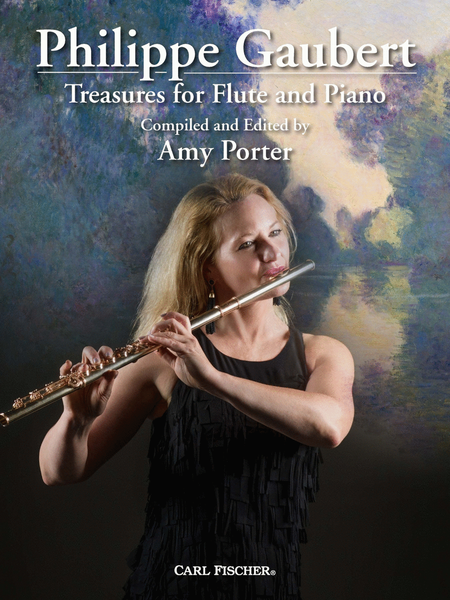Treasures for Flute and Piano
Philippe Gaubert
-
Ships in 1 to 2 weeks
Details
Description
SKU: CF.WF228
Philippe Gaubert. Composed by Philippe Gaubert. Edited by Amy Porter. Arranged by Amy Porter. Set of Score and Parts. With Standard notation. Carl Fischer Music #WF228. Published by Carl Fischer Music (CF.WF228).ISBN 9781491153529. 9 x 12 inches.
Compiled and edited by Amy Porter, Treasures for Flute and Piano is acollection of Philippe Gaubert’s shorter works for flute and piano. Gaubertwas a multi-talented musician, a marvelous flutist as well as a composer,teacher, and master conductor. Over his lifetime, he became one of the mostimportant musical figures in France between the World Wars in the first halfof the 20th century. Trained in theory and harmony at the Paris Conservatory,Gaubert was also deeply influenced by other composers at the time, includingDebussy, Fauré, and Dukas. Editor Amy Porter is a distinguished Professorat The University of Michigan School of Music, Theatre & Dance, and hasbeen praised by critics for her exceptional musical talent and her passion forscholarship. This edition represents eleven of the sixteen works from AmyPorter and Dr. Penelope Fischer’s video study guide, “The Gaubert Cycle: TheComplete Works for Flute and Piano by Philippe Gaubert”.
Philippe Gaubert (1879–1941) was a very important teacher and flutist in our classical flute playing lineage. In this edition we have gathered his beautiful, shorter compositions for flute and piano all in one place, to be cherished as “Gaubert’s Treasures.”Philippe Gaubert personified the modern French school of flute playing as introduced by his teacher Paul Taffanel (1844–1908) at the Paris Conservatory. Gaubert was a multitalented musician, a marvelous flutist as well as a gifted composer, teacher and master conductor. Over his lifetime he became one of the most important musical figures in France between the World Wars in the first half of the twentieth century. Gaubert’s musical andpedagogical gifts to us are passed along through generations of students and continue to touch the hearts of many who listen to his fine, and refined, music.Philippe Gaubert studied composition at the Paris Conservatory with Raoul Pugno, Xavier Leroux, and then for a brief time with Charles Lenepvu. It was after this study that he won the famous Prix de Rome second prize in composition. Even with his schooling of theory and harmony in Paris, he was deeply influenced by other composers of the time, namely Debussy, Fauré and Dukas. Between the years of 1905–1914 Gaubert’s early workswere arrangements and short pieces written for the year-end final exam pieces at the Conservatory.Between 1914–1918 Gaubert served in the French Army during World War I, most notably in the battle of Verdun in 1916. This was considered one of the largest battles against the Germans in WWI. He was wounded but his creativity level was not dampened. He was rewarded for his service and awarded medals for his bravery. It was during this time that he found the energy to compose his Deux Esquisses or 2 Scenes, and sketched out his first flute sonata.Gaubert composed his remaining five flute and piano works after 1922 in Paris, and clearly his poetic soul was transformed from the earlier years. He took in new forms and styles of compositions such as a Suite, a Ballade and a Sonatine. He also completed his Second and Third Sonatas for Flute and Piano, all of them dramatic works in terms of compositional techniques and grandeur of tone.Gaubert composed music easily throughout his lifetime, especially during summer breaks when the orchestra and Paris Opera seasons were on hiatus and he was not conducting. He loved literature and poetry which inspired over thirty vocal works from 1903 through 1938.He also wrote twenty-six instrumental chamber works for other instruments: oboe, cornet, clarinet, trombone, violin, viola, cello, harp and combinations of these instruments with piano. Some of these were commissioned jury pieces, but many were for his musician friends.Six full-length stage works, both ballets and operas for the stage, several tone poems and symphonies were written throughout his lifetime.This edition represents eleven out of the sixteen works from our video study guide “The Gaubert Cycle: The Complete Works for Flute and Piano by Philippe Gaubert” with guest pianist Tim Carey. Omitted in this edition are Sonatas Nos. 1–3, Ballade, and Sonatine.

 Share
Share